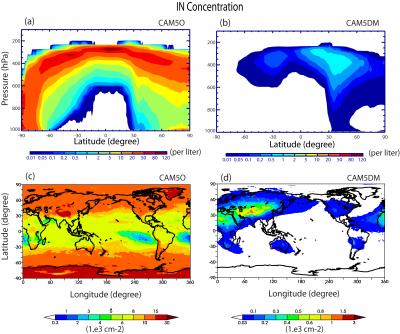Linking Ice Nucleation to Aerosols and Its Impact on CAM5 Simulated Arctic Clouds and Radiation
Ice nuclei (IN) play an important role in the glaciation of mixed-phase clouds, which dominate low-level Arctic clouds especially during cold seasons, however, the treatment of ice nucleation processes in current climate models is often oversimplified. They are usually parameterized as a function of temperature and/or ice super-saturation while ignoring IN temporal and spatial variability as a function of aerosol properties. The ice number density produced by such ice nucleation schemes is much larger than what is observed in the Arctic. To improve parameterizations of ice nucleation processes, scientists at Lawrence Livermore National Laboratory (LLNL) and Pacific Northwest National Laboratory have worked together to implement a new physically based ice nucleation scheme (DeMott et al. 2010) that links the variation of ice nuclei (IN) number concentration to aerosol properties into the Community Atmospheric Model version 5 (CAM5). The default scheme (Meyers et al. 1992) parameterizes the IN concentration simply as a function of ice supersaturation. The goal of this study is to better understand the important role of ice nucleation processes in clouds and radiation simulated by climate models with an emphasis on the Arctic region. Specifically, we would like to know how modeled cloud types and their properties vary with the treatment of ice nucleation processes and how these changes impact Earth’s radiative budget.
The new scheme leads to a significant reduction in simulated IN number concentrations at all latitudes (Figure 1) while changes in cloud amount and cloud properties are mainly seen in high latitudes and middle latitude storm tracks. In the Arctic, there is a considerable increase in mid-level clouds and a decrease in low clouds, which result from the complex interaction among the cloud macrophysics, microphysics, and the large-scale environment. The smaller IN concentrations result in an increase in liquid water path and a decrease in ice water path due to the slow-down of the Bergeron-Findeisen process in mixed-phase clouds. Overall, there is an increase in the optical depth of Arctic clouds, which leads to a stronger cloud radiative forcing (net cooling) at the top of the atmosphere.
The comparison with satellite data shows that the new scheme slightly improves low cloud simulations over most of the Arctic, but produces too many mid-level clouds. Considerable improvements are seen in the simulated low clouds and their properties when compared to Arctic ground-based measurements collected from the Department of Energy’s Atmospheric Radiation Measurement (ARM) Climate Research Facility.
The significant reduction in simulated IN number concentrations in mixed-phase clouds resulted from using a new and more physically based ice nucleation scheme, leading to a considerable changes in Arctic clouds and their properties. Overall, there is an increase of the optical depth of Arctic clouds, which leads to a stronger cloud radiative forcing (net cooling) at TOA compared to the default model. This suggests that the new IN scheme would produce less warming in its simulated Arctic climate than the default scheme.
The efforts of authors were supported by the Earth System Modeling program and the Atmospheric System Research program of the United States Department of Energy’s Office of Science. Work at LLNL was performed under the auspices of the U. S. Department of Energy, Office of Science, Office of Biological and Environmental Research by Lawrence Livermore National Laboratory under contract No. DE-AC52-07NA27344. The Pacific Northwest National Laboratory is operated for the DOE by Battelle Memorial Institute under contract DE-AC06-76RLO 1830.

